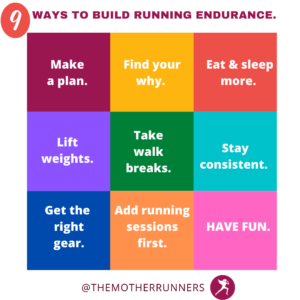One of the main goals of running is to run longer without stopping. People stop running for many reasons: we are low on energy. Our bodies hurt. We’re bored. Or, we just don’t have motivation.
The trouble is most people go out the gate expecting to be able to run fast and far before their bodies (and minds) are ready. The sport of running rewards those who put in the work, day in and day out.

People who are consistent and patient with their running achieve the ability to run faster and longer and get that elusive runner’s high.
In this article, I’m going to cover:
- What is running stamina
- Why you can’t run continuously
- and 10 steps for running longer without stopping
So, let’s go!
Related: How to Keep Running When You’re Tired
What is running stamina?

Running stamina is your body and mind’s ability to maintain an effort for a long period of time. It is similar to endurance, or running endurance, which is your body and mind’s ability to maintain this effort when tired.
Why can’t I run continuously?
If you stop a lot while running it is likely because you lack running stamina. Your aerobic system isn’t ready to run for that long. Your muscles, bones, and connective tissues aren’t strong enough for the duration of the impact. You can’t just jump into a longer run. You must work up to it and let your body adapt.
How can I run longer without getting tired?
The key to running longer without getting tired is running more. Don’t expect to run a few times a week for a few weeks, take a break for a few weeks, and return to the same level. Your body needs exposure to those stressors week over week in order to spur the physiological adaptations needed to increase running stamina.
And, it can take ten days to several weeks to feel the effects of a run. So, hang in there! It gets easier the more you do it!
How do people run longer?
The key to running longer is doing it consistently for a long time in a measured way. People who increase running mileage too quickly (more than 10 percent in running volume week to week) will likely get injured. People who run too fast on their easy runs will also likely get hurt.
Patience and consistency are the bedrock of running success and teaching your body to run longer and faster.
10 Steps for How to Run Longer
Alright, now let’s get to the good part—actionable steps to increase endurance so you can run longer without stopping.
-
Find your motivation.
The biggest barrier that causes people to quit running is losing motivation.
So, before you start lacing up those running shoes, find your why! And make sure it matters in your soul (aka intrinsic motivation).
Is it because you want to be a healthier parent who can run and play with your kids? Or because running makes you feel good about yourself and thus you’re nicer to your family? Maybe it’s because you want to set a good example for your kids?
If training for a race helps keep you accountable and excited about running, then choose one and sign up!
Running offers us a host of mental and physical benefits that go beyond losing weight and feeling good. Often people start running to lose weight but find that it also makes them feel good and empowers them in other areas of your life.
Find your why, write it down, and don’t forget it when the going gets tough and you want to stop running!
Related: Science-backed Reasons Running Makes You a Better Mom
-
Get the right running gear.
Nothing is going to stop a runner in her tracks than chafing, or uncomfortable running shoes, or clothes that make her feel sloppy. So, head to your local running store, or Lululemon, or Vuori or Tracksmith, and pick out some running gear that gets you excited about running!
When picking running shoes, it’s best that someone watches your running gait to ensure the shoe is the right match. Try to buy running shoes from a place that offers a return policy for slightly used shoes.
And, grab some body glide or Vaseline to lube up areas on your body that will rub against your clothes or shoes to minimize chafing or blisters.
-
Look hard at your schedule.

Pin these tips to run longer for later.
Another huge barrier to running is not having the time. You can’t wait for a window to magically open up. You got to make it happen! So look hard at your schedule and see where you might be able to fit in a run. Will you need to run in the early morning? Can you run at lunch? Are you able to hire a sitter? Could you prep a sheet pan meal so dinner is easy and you can run after work?
Markdown your running times on a calendar. Tell your partner and your family and stay committed. The critical way to run longer (and to run faster and longer) is to be consistent with your running.
The more running sessions you have per week, the more changes are triggered in your body to improve running endurance (like more mitochondria, denser capillaries, stronger muscles, and bones, etc.)
Related: The Benefits of the Long Run
-
Walk.
Walk? How can I talk about taking walk breaks in an article about running without stopping?
Well, walk breaks are great for beginner runners or those returning to run because they ease the stress on your body that running can have. They also help build mental and muscular endurance as the body doesn’t know how far you run but knows how much time you spend on your feet.
You should aim to run for thirty minutes a running session. That’s according to renowned running coach Jack Daniels. This is the amount of time it takes for your body to really start making those crucial physiological changes that increase running stamina. If walk breaks help you hit 30 minutes, do it!
It’s important to note that any running is better than none, so if you only have 15 or 20 minutes to run, do it. All those little changes in the body will add up in the long run.
Related: Free Walk to Run Training Plan
-
Add running days per week.
This brings me to another important point. When you begin increasing your mileage, start by adding another day of running over elongating current runs. That’s because the more sessions of running you have, the more these physiological adaptations are triggered in your body.
So, say you are running 20 miles a week over the course of 4 runs, and you want to run 22 miles a week the next week. Instead of adding mileage to your current runs, add a fifth day of running 3 miles (and steal a mile from one of the other days). The more running sessions you have in your base the better.
Once you are at four or five days running a week, begin elongating one of your runs. (There are many caveats when it comes to adding mileage, so having a coach or training plan is extremely helpful!)
-
Vary your runs.
Once you have a solid base of running four days or so a week, you can start adding in different types of runs such as a long run, and eventually strides, tempo runs, and even intervals (depending on your goal).
Endurance running always begins with building a strong base of easy miles which strengthens your body against the stress of running. When you begin adding different lengths and speeds of running, you teach your body how to move more efficiently.
Related: How to Do a Tempo Run
Begin by adding in one longer run per week which should be about 30 percent of your total weekly volume. Then you can segue to strides, fartleks, tempos, and intervals on the track (depending on your goal) which multiply training effects such as your aerobic and anaerobic endurance, VO2 max, and running economy.
Essentially, you want to ensure the majority (usually about 80 percent) of your runs are done at an easy pace and the rest (about 20 percent) are run at a harder effort.
A training plan or running coach can guide you in what workouts you should be doing.
Related: The Benefits of Running an Easy Pace
-
Make it fun.

Take care of yourself to keep running!
Speaking of variation, keep running fun by varying where you run, who, and what you run with.
Personally, I like to alternate between running by myself and running with friends. Running with a training partner or running group can be a great way to hold you accountable and get you out of bed. You can ask a friend to train for a race with you or find a running group through your local shoe store, track club, or race.
Run to music, podcasts like my The Passionate Runner podcast! (shameless plug), or audiobooks to keep things interesting.
-
Strength train.
A great way to run for longer without actually running is to hit the weight room. Studies show strength training helps runners run faster and longer—including an 8 percent boost in running economy (how much energy it takes to run a certain pace) in runners who lifted weights.
Get all the details on how to lift weights in my Strength Training Runners Guide but aim for two 30-minute sessions per week using basic moves such as lunges, squats, step-ups, and deadlifts using heavy weights plus plyometrics.
Download my free strength plan for runners here.
-
Fuel properly.
Eating a small snack of a couple of hundred calories of mostly carbs before your run will give your body the fuel it needs to go the distance. Refuel within 30 minutes after a run gives your body the fuel it needs to repair itself to build back stronger.
The best foods to eat before a run include a bagel, oatmeal, banana, graham crackers, or waffle.
The best foods to eat after a run include a protein smoothie with fruit, chocolate milk, or a bagel with peanut butter.
Supplements like CoQ10 and ashwagandha have also been found to increase running endurance. Just be sure you check with your doctor before taking them!
Related: Marathon Fueling 101, How Runners Should Eat
-
Sleep!
The more you run, the more sleep you need because your body has more work to do! When you run, you essentially break down your body and during sleep is when your body builds itself back up.
So, make sure you’re getting at least 7 to 8 hours. Sleep experts recommend an extra minute a night per mile you run a week. So, if you run thirty miles a week, you need to sleep an extra thirty minutes a night!
It’s also important to note, that lack of sleep has been found to decrease endurance performance. It makes sense. If you’re already exhausted heading out the door, it’s going to be hard to run longer without stopping.
I’d love to help you with your running goals! Check out my run coaching services to see if we’d be a good fit!


